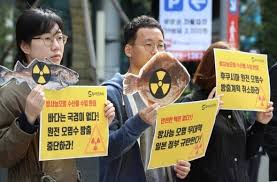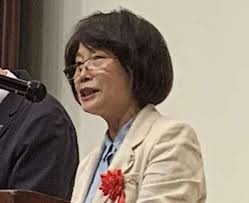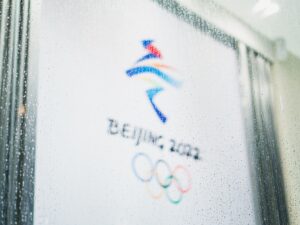
It will be one year on the 24th of this month since Japan began discharging radioactive treated water from the Fukushima nuclear power plant into the ocean. Last summer, South Korean political circles stirred up anti-Japanese sentiment with inflammatory slogans such as “nuclear wastewater” and “cesium blackfish” in response to the ocean discharge. At the time, customers stopped coming to the Sagiryangjin Seafood Market in Seoul, the largest seafood market in South Korea, and other seafood markets across the country. Merchants were looking after their deserted stores and sighing, “What have we done?
However, when this newspaper’s reporters visited the Sagiryangjin Marine Products Market on the afternoon of the 19th of this month, the “radiation hoax” seemed to have been completely forgotten. Dozens of shoppers were browsing in the “ikebasu” where flounder and sea bream were swimming. How much do you want?” and “Give me a little extra,” were exchanged here and there. All the vessels filled with horse mackerel, sea bream, yellowtail, yellowtail, saffron cod, and sea bream were clearly labeled “Japan” as the place of origin, but no one paid any attention to it. An electronic bulletin board in the center of the market announced that on the 16th, a radiation test conducted by the Korea Fisheries Cooperative Association had determined that all Japanese red sea breams and yellowtail snapper were “compliant” in terms of iodine, cesium, and other parameters. It also showed a video clip of the Korean Seafood Cooperative Association stating, “In Korea, when inspecting the radioactivity of marine products, they apply a standard of 100 becquerels per kilogram, which is 10 times stricter than international standards and developed countries. Since the start of the ocean discharge last year, the association has been conducting daily (except weekends) radiation inspections of Japanese fishery products. Shoppers said that there are tastier species of fish from Japan than from Korea, and that they buy and eat tasty Japanese fish without worrying about false rumors. Mr. Shin, 60, who buys sashimi at the Sagryangjin seafood market once a month, said, “The texture of Japanese horse mackerel is much better than that of Korean horse mackerel, and Japanese horse mackerel is excellent. Shin said of the claims made a year ago by the South Korean opposition about “radioactive fish” and other such claims, “What country or government in the world would allow its citizens to import and eat such fish? The Korean government conducted about 44,000 radiation tests on Japanese seafood over the past year, but not a single case of results approaching the standard values was found.
Another shopper, Lee, 54, said, “I’m going to buy Korean nibbles, ascidians, and abalone and eat them at home. He added, “I heard that Korea is the slowest place for Fukushima contaminated water to reach, considering the ocean currents, but the hoax is not true. Why are you saying that so many people are gathering here now? He added, “I was in Osaka the day before yesterday, and Korean tourist groups often ate fish that were not labeled as to their origin. At the time of the ocean discharge last year, nuclear academics around the world said that most radioactive nuclides were first “filtered” through the ALPS system, and tritium (tritium that cannot be removed even by this process) was diluted with seawater to reduce it below the World Health Organization’s standard (10,000 becquerels per liter). He stated that this would not be a problem. Merchants at the Sagiryangjin seafood market said, “Few consumers are worried about radiation anymore. In fact, Japanese seafood is more popular than Korean because it tastes better. Kim Sun-yeol, 50, who runs Sinnamdo Fisheries in the market, said, “Japanese red sea bream is fed with shrimp, so the texture is superb. Japanese horse mackerel is also popular among young people (in Korea) because word of mouth has spread that it tastes the same as Korean yellowtail,” he said. Cha Duk-ho, 54, president of the market’s merchants’ association and owner of a restaurant called Tankgukchon, added, “Even if it says ‘from Japan,’ no customers ask about contaminated water or radiation. All of our sea bream and striped horse mackerel are from Japan, and they are among the top three sellers at our store,” he said. According to statistics from the Korea Marine Fisheries Development Institute, imports of Japanese seafood in the first half of this year totaled 18,106 tons. This figure is a 13.2% increase over the first half of last year (15,994 tons), just before the ocean release of radioactive treated water from the Fukushima nuclear power plant, and is the highest since 2017 (18,399 tons) on a first half basis. By commodity, scallops (5,316 tons), shellfish (2,749 tons), sea bream (2,380 tons), yellowtail (2004 tons), and Japanese sardines (1,103 tons) had the highest import volumes. Experts commented, “This is a phenomenon that shows how far the political circles that spread the hoax, which is outrageous even from a common sense standpoint, and the ardent supporters who unnecessarily backed it, are out of step with the universal common sense of the people. This is a clear example of the fact that a hoax is effective for less than a year. Jeong Beom-jin, a professor in the Department of Nuclear Engineering at Kyung Hee University, said, “Common sense tells us that Japan would release radioactive materials into the ocean at a level that would cause harm to its own citizens. I have bitter memories of last year, when even the experts who spoke about natural scientific truths were divided into pro-Japanese and anti-Japanese camps,” he said. Byung-Kwon Kim and Jee-Woong Kang, Chosun Ilbo










